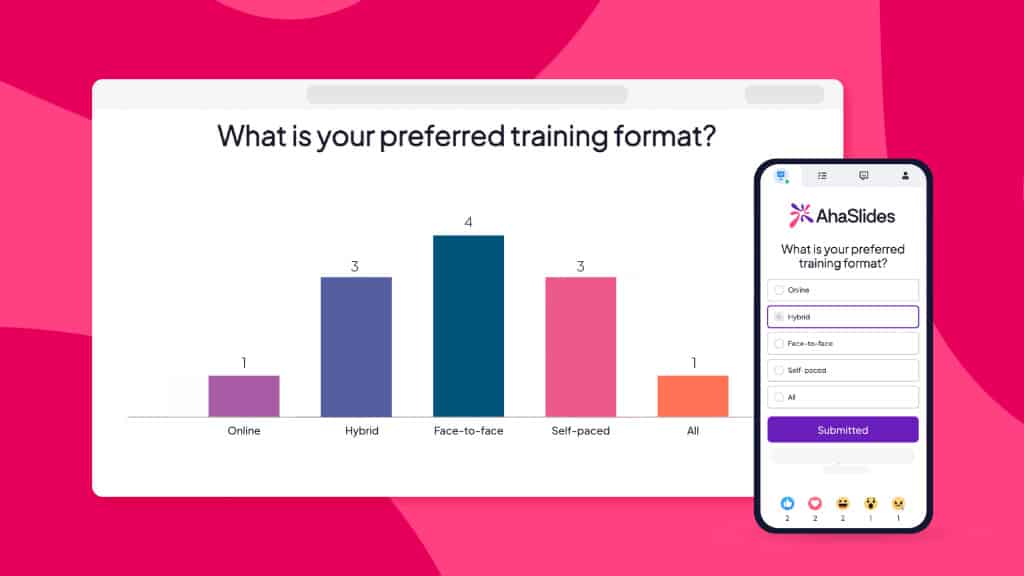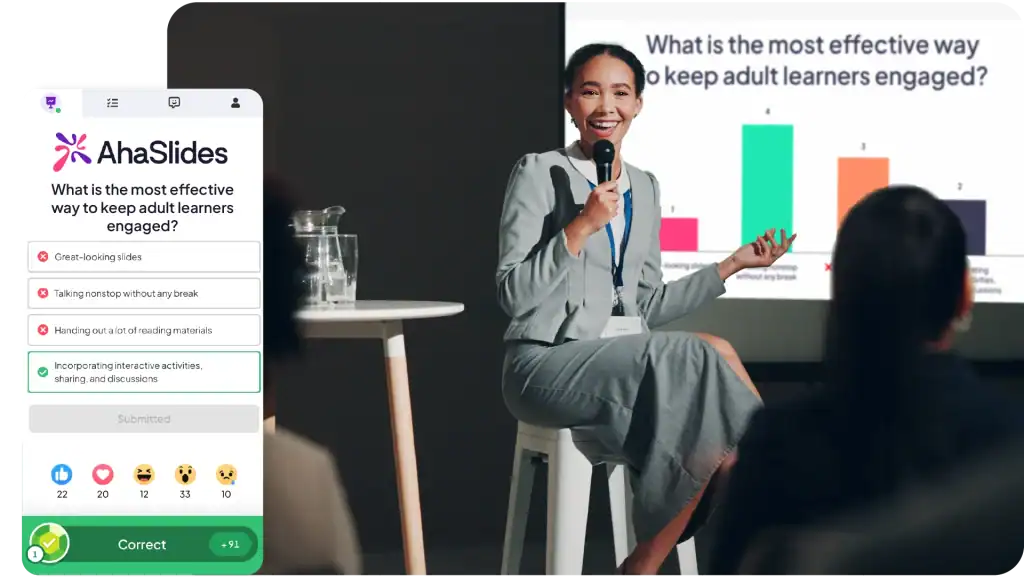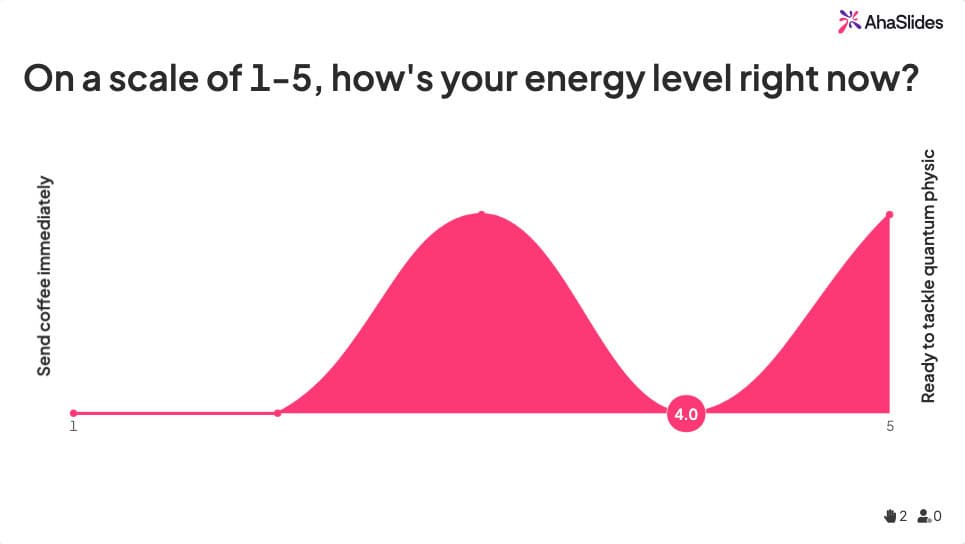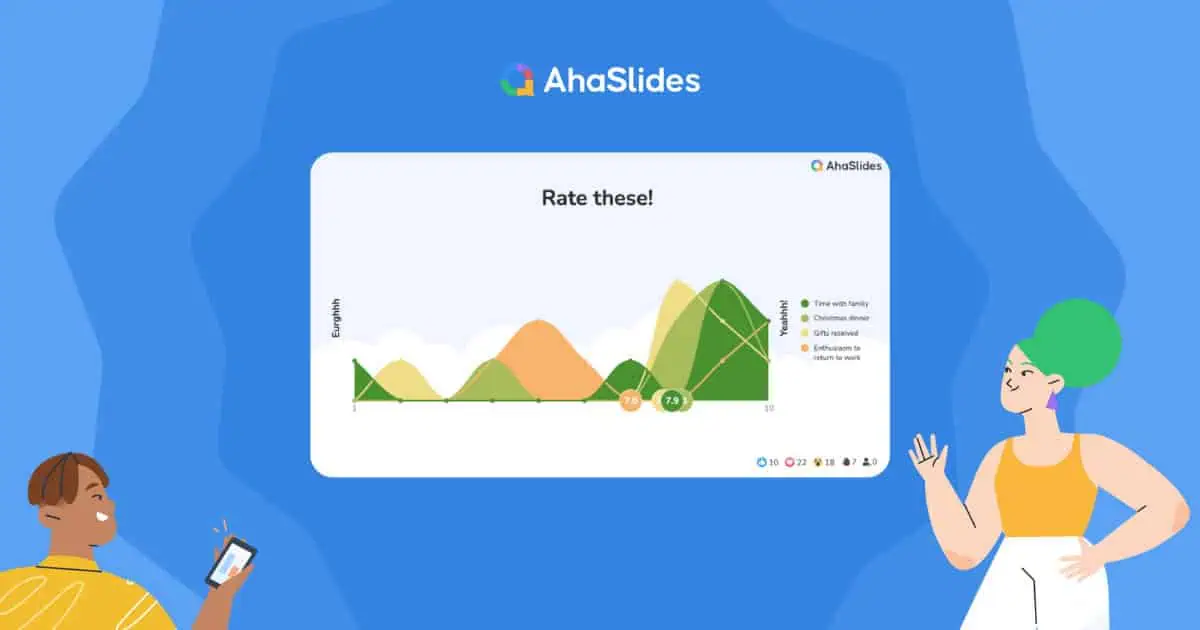Dalam ekonomi perhatian yang dilatih oleh TikTok hari ini, anda mempunyai kira-kira 8 saat untuk menarik minat seseorang—kurang masa daripada ikan emas. Jika ia kelihatan menakutkan untuk pembentangan selama 5 minit, inilah berita baiknya: pembentangan pendek ialah senjata rahsia anda.
Semasa yang lain bergelumang melalui geladak 60 slaid sambil melihat mata berkaca-kaca, anda akan menyampaikan mesej tertumpu yang melekat. Sama ada anda mengemukakan pendapat kepada pelabur, melatih pasukan terpencil, membentangkan penemuan penyelidikan atau menemu bual untuk peranan impian anda, menguasai format 5 minit bukan sahaja mudah—ia menentukan kerjaya.
Panduan ini menggunakan sains pembentangan, cerapan daripada jurulatih profesional yang menyampaikan ratusan sesi setiap tahun, dan teknik terbukti daripada penceramah TED untuk membantu anda membuat pembentangan yang menarik, memujuk dan meninggalkan kesan yang berkekalan.
Jadual Kandungan
Mengapa Pembentangan 5 Minit Memerlukan Pendekatan Berbeza
Penyelidikan daripada ahli sains saraf John Medina menunjukkan bahawa perhatian penonton menurun dengan ketara setiap 10 minit semasa pembentangan tradisional. Dalam tetapan maya, tetingkap itu mengecut kepada hanya 4 minit. Pembentangan selama 5 minit anda sesuai dengan keseronokan pertunangan ini—tetapi hanya jika anda mereka bentuknya dengan betul.
Pertaruhannya lebih tinggi dengan pembentangan pendek. Setiap perkataan adalah penting. Setiap slaid penting. Tiada masa untuk pengisi, tiada ruang untuk tangen, dan toleransi sifar untuk masalah teknikal. Penyelidikan industri menunjukkan bahawa 67% daripada profesional kini lebih suka pembentangan yang ringkas dan berfokus berbanding yang panjang-namun kebanyakan pembentang masih mendekati ceramah pendek sebagai versi ringkas daripada yang panjang, yang jarang berfungsi.
Cara Membuat Persembahan 5 Minit
Langkah 1: Pilih Topik Anda Dengan Ketepatan Pembedahan

Kesilapan terbesar penyampai? Cuba untuk menutup terlalu banyak tanah. Pembentangan 5 minit anda harus ditangani satu idea teras—bukan tiga, malah dua. Fikirkan ia sebagai laser, bukan lampu limpah.
Topik anda mesti lulus ujian empat bahagian ini:
- Titik fokus tunggal: Bolehkah anda menerangkannya dalam satu ayat? Jika tidak, sempitkannya.
- Perkaitan khalayak: Adakah ia menyelesaikan masalah yang mereka hadapi secara aktif? Langkau maklumat yang mereka sudah tahu.
- Kesederhanaan: Bolehkah anda menerangkannya tanpa latar belakang yang kompleks? Simpan topik yang rumit untuk format yang lebih panjang.
- Kepakaran anda: Berpegang kepada subjek yang anda tahu dengan mendalam. Masa penyediaan adalah terhad.
Untuk inspirasi, pertimbangkan topik 5 minit yang terbukti merentasi konteks yang berbeza:
- Tetapan profesional: 3 strategi dipacu data untuk mengurangkan pergolakan pelanggan, Bagaimana alatan AI membentuk semula aliran kerja kami, Mengapa keputusan Q3 kami menandakan pangsi strategik
- Latihan & P&P: Satu tabiat yang mengubah prestasi pasukan jauh, Psikologi di sebalik markah penglibatan pekerja, Cara memberi maklum balas yang sebenarnya meningkatkan tingkah laku
- Konteks akademik: Penemuan utama daripada penyelidikan kemampanan saya, Bagaimana media sosial mempengaruhi pembuatan keputusan remaja, Etika penyuntingan gen dalam tiga senario sebenar
Langkah 2: Reka Bentuk Slaid Yang Menguatkan (Tidak Mengganggu)
Inilah kebenaran yang memisahkan penyampai amatur daripada profesional: anda adalah pembentangan, bukan slaid anda. Slaid harus menyokong naratif anda, bukan menggantikannya.
Soalan kiraan slaid
Penyelidikan daripada pakar pembentangan mencadangkan 5-7 slaid untuk ceramah 5 minit—kira-kira satu slaid seminit dengan masa untuk pembukaan dan penutupan anda. Walau bagaimanapun, pembesar suara TED kadangkala menggunakan 20 slaid yang maju dengan cepat (10-15 saat setiap satu) untuk mengekalkan momentum visual. Apa yang lebih penting daripada kuantiti ialah kejelasan dan tujuan.
Prinsip reka bentuk kandungan
- Teks minimum: Maksimum 6 perkataan setiap slaid. Skrip 700 perkataan anda hendaklah dituturkan, bukan dipaparkan.
- Hierarki visual: Gunakan saiz, warna dan ruang putih untuk membimbing perhatian kepada perkara yang paling penting.
- Visualisasi data: Satu statistik atau graf yang menarik bagi setiap slaid mengalahkan perenggan penjelasan.
- Reka bentuk yang konsisten: Fon, warna dan reka letak yang sama sepanjang mengekalkan profesionalisme.
Tip: Jadikan pembentangan anda interaktif menggunakan tinjauan langsung, ciri Soal Jawab atau kuiz pantas. Ini mengubah penonton pasif kepada peserta aktif dan secara dramatik meningkatkan pengekalan maklumat. Alat seperti AhaSlides membolehkan anda membenamkan ciri ini dengan lancar, walaupun dalam format 5 minit.

Langkah 3: Kuasai Masa Dengan Ketepatan Tentera
Dalam pembentangan selama 5 minit, setiap saat mempunyai tugas. Tiada penampan untuk bertele-tele atau pulih daripada kesilapan. Penceramah profesional mengikuti struktur yang diuji pertempuran ini:
Formula peruntukan masa yang terbukti
- 0:00-0:30 – Cangkuk pembukaan: Tarik perhatian dengan fakta yang mengejutkan, soalan provokatif atau cerita yang menarik. Langkau perkenalan yang panjang lebar.
- 0:30-1:30 – Masalahnya: Tetapkan sebab khalayak anda perlu mengambil berat. Apakah cabaran yang ditangani oleh topik anda?
- 1:30-4:30 – Penyelesaian/wawasan anda: Ini adalah kandungan teras anda. Sampaikan 2-3 perkara penting dengan bukti sokongan. Potong apa-apa yang tidak penting.
- 4:30-5:00 – Kesimpulan & seruan tindak: Teguhkan mesej utama anda dan beritahu penonton apa yang perlu dilakukan seterusnya.
Pelarasan persembahan maya
Mempersembahkan dari jauh? Bina dalam momen pertunangan setiap 4 minit (setiap penyelidikan Medina). Gunakan tinjauan pendapat, minta respons sembang atau kemukakan soalan retorik. Periksa sudut kamera anda (paras mata), pastikan pencahayaan yang kuat dari hadapan dan uji kualiti audio terlebih dahulu. Khalayak maya lebih terdedah kepada gangguan, jadi interaksi bukanlah pilihan—ia adalah penting.

Langkah 4: Sampaikan Dengan Keyakinan Tulen

Malah kandungan cemerlang gagal dengan penyampaian yang lemah. Begini cara profesional mendekati saat kebenaran:
Berlatih seperti kerjaya anda bergantung padanya (kerana mungkin)
Latih tubi pembentangan 5 minit anda sekurang-kurangnya 5-7 kali. Gunakan pemasa. Rakam diri anda dan tonton kembali—menyakitkan tetapi tidak ternilai. Berlatih sehingga anda boleh menyampaikan kandungan anda secara semula jadi tanpa membaca slaid. Ingatan otot membawa anda melalui rasa gementar.
Teknik penyampaian yang memisahkan amatur daripada profesional
- Variasi vokal: Pelbagaikan rentak, nada dan kelantangan. Jeda secara strategik untuk penekanan—senyap itu berkuasa.
- Bahasa badan: Secara peribadi, gunakan gerak isyarat terbuka dan bergerak dengan tujuan. Pada kamera, hadkan gerak isyarat (ia menguatkan) dan kekalkan hubungan mata dengan kanta.
- Bercerita: Jalin dalam contoh atau anekdot yang ringkas dan relevan. Cerita meningkatkan pengekalan sebanyak 22x berbanding fakta sahaja.
- Pengurusan tenaga: Padankan tenaga anda dengan mesej anda. Bersemangat untuk inspirasi, diukur untuk topik yang serius.
- Kesediaan teknikal: Peralatan ujian 30 minit lebih awal. Mempunyai pelan sandaran untuk isu ketersambungan.
Rahsia sambungan penonton
Fikirkan pembentangan anda sebagai perbualan, bukan persembahan. Kekalkan hubungan mata (atau lihat pada kamera untuk pembentangan maya). Akui reaksi. Jika anda tersandung, berhenti sebentar dan teruskan—khalayak memaafkan keaslian, tetapi tidak membaca slaid secara robotik.
Petua rahsia: Tidak tahu sama ada pembentangan 5 minit anda memberi kesan? Gunakan a alat maklum balas untuk mengumpul sentimen penonton dengan segera. Ia memerlukan usaha yang minimum, dan anda mengelakkan kehilangan maklum balas yang berharga sepanjang perjalanan.

5 Kesilapan Biasa Semasa Memberi Persembahan 5 Minit
Kami mengatasi dan menyesuaikan diri melalui percubaan dan kesilapan, tetapi lebih mudah untuk mengelakkan kesilapan rookie jika anda tahu apa itu👇
- Berjalan mengikut masa: Notis penonton. Ia menandakan persediaan yang lemah dan tidak menghormati jadual mereka. Berlatih untuk selesai pada 4:45.
- Slaid berlebihan: Slaid berteks tinggi membuatkan penonton membaca dan bukannya mendengar. Anda kehilangan perhatian mereka serta-merta.
- Latihan ponteng: "Ia hanya 5 minit" adalah pemikiran berbahaya. Format pendek menuntut LEBIH BANYAK amalan, bukan kurang.
- Cuba untuk merangkumi segala-galanya: Kedalaman mengalahkan keluasan. Satu pandangan jelas yang bergema adalah lebih baik daripada lima mata yang tidak diingati oleh sesiapa pun.
- Mengabaikan khalayak anda: Sesuaikan kandungan mengikut minat, tahap pengetahuan dan keperluan mereka. Pembentangan generik tidak pernah tiba.
Contoh Persembahan 5 Minit
Kaji contoh ini untuk melihat prinsip dalam tindakan:
William Kamkwamba: 'Bagaimana Saya Memanfaatkan Angin'
ini TED Talk video membentangkan kisah William Kamkwamba, seorang pencipta dari Malawi yang, sebagai seorang kanak-kanak yang mengalami kemiskinan, membina kincir angin untuk mengepam air dan menjana elektrik untuk kampungnya. Penceritaan Kamkwamba yang semula jadi dan lugas mampu memikat penonton, dan penggunaan jeda pendek beliau untuk orang ketawa juga merupakan satu lagi teknik yang hebat.
Susan V. Fisk: 'Kepentingan Menjadi Ringkas'
ini latihan video menawarkan petua berguna untuk saintis menstrukturkan ceramah mereka agar sesuai dengan format pembentangan "5 Minit Rapid", yang juga dijelaskan dalam masa 5 minit. Jika anda bercadang untuk membuat pembentangan pantas "Cara-cara", lihat contoh ini.
Jonathan Bell: 'Cara Mencipta Nama Jenama yang Hebat'
Seperti yang dicadangkan oleh tajuk, penceramah Jonathan Bell akan memberi anda a panduan langkah demi langkah tentang cara mencipta nama jenama yang berkekalan. Dia terus kepada intipati dengan topiknya dan kemudian memecahkannya kepada komponen yang lebih kecil. Contoh yang baik untuk dipelajari.
Invois PACE: 'Ladang 5 Min di Startupbootcamp'
Video ini menunjukkan bagaimana Invois PACE, syarikat permulaan yang mengkhusus dalam pemprosesan pembayaran berbilang mata wang, dapat melontarkan ideanya kepada pelabur dengan jelas dan padat.
Will Stephen: 'Cara Membunyikan Pintar dalam Ceramah TEDx Anda'
Menggunakan pendekatan lucu dan kreatif, Will Stephen's TEDx Talk membimbing orang ramai melalui kemahiran umum pengucapan awam. Mesti tonton untuk mencipta persembahan anda menjadi karya agung.
Bersedia untuk membuat pembentangan yang benar-benar menarik? Mulakan dengan alat persembahan interaktif AhaSlides dan ubah pembentangan 5 minit anda yang seterusnya daripada boleh dilupakan kepada tidak dapat dilupakan.








